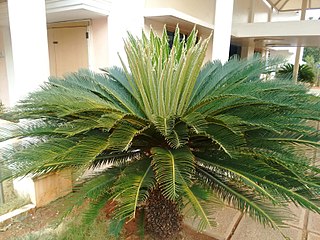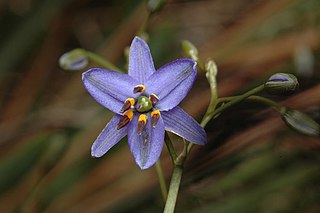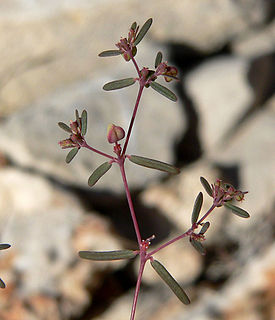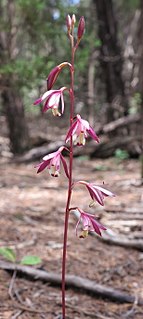
Cycas is a genus of plants belonging to a very ancient lineage, the Cycadophyta, which are not closely related to palms, ferns, trees or any other modern group of plants. They are evergreen perennials which achieved their maximum diversity in the Jurassic and Cretaceous periods, when they were distributed almost worldwide. At the end of the Cretaceous, when the non-avian dinosaurs became extinct, so did most of the cycas in the Northern Hemisphere.

Cycas revoluta, is a species of gymnosperm in the family Cycadaceae, native to southern Japan including the Ryukyu Islands. It is one of several species used for the production of sago, as well as an ornamental plant.

Hexalectris is a genus of the family Orchidaceae, comprising 10 known species of fully myco-heterotrophic orchids. These species are found in North America, with the center of diversity in northern Mexico. None of the species are particularly common. Hexalectris spicata has a wide distribution and is likely the most abundant member of the genus, but is nevertheless infrequent throughout its range. Other species are rare, and some, such as H. colemanii, are threatened or endangered. All species that have been studied form associations with ectomycorrhizal fungi that are likely linked to surrounding trees. Many Hexalectris species are found in association with oak trees (Quercus), which are ectomycorrhizal.

Dianella is a genus of about forty species of flowering plants in the monocot family Asphodelaceae and are commonly known as flax lilies. Plants in this genus are tufted herbs with more or less linear leaves and bisexual flowers with three sepals more or less similar to three petals and a superior ovary, the fruit a berry. They occur in Africa, South-east Asia, the Pacific Islands, New Zealand and Australia.

Euphorbia revoluta is a species of euphorb known by the common name threadstem sandmat. It is native to Mexico and the southwestern United States from California to the Rocky Mountains. It is an annual herb producing thin, erect stems with pairs of linear leaves, each leaf up to 2.6 centimeters long. The inflorescence is a cyathium with rounded nectar glands surrounding one female flower and several male flowers. There are sometimes white petal-like appendages as well. The Navajo used this plant as a skin lotion.

Dianella revoluta, commonly known as blueberry lily, blue flax-lily, or black-anther flax-lily, a species of flowering plant in the family Asphodelaceae and is endemic to, and widespread in Australia. It is a tufted, perennial herb with grass-like leaves and up to nine blue or violet flowers with six tepals, and stamens with bright yellow filaments and pale brown to almost black anthers.
Platanthera colemanii is a rare species of orchid known by the common names Coleman's piperia and Coleman's rein orchid. It is endemic to California, where it is known from scattered occurrences along the Sierra Nevada and one disjunct location in Colusa County, California. It grows in coniferous forests and chaparral in deep sandy substrates. It was differentiated from the very similar Platanthera unalascensis in 1993.

Persoonia mollis, commonly known as soft geebung, is a plant in the family Proteaceae and is endemic to New South Wales. It is an erect to prostrate shrub with linear to oblong or spatula-shaped leaves, yellow flowers in groups of up to thirty on a rachis up to 150 mm (5.9 in) long and relatively small fruit.

Orites revolutus , also known as narrow-leaf orites, is a Tasmanian endemic plant species in the family Proteaceae. Scottish botanist Robert Brown formally described the species in Transactions of the Linnean Society of London in 1810 from a specimen collected at Lake St Clair. Abundant in alpine and subalpine heath, it is a small to medium shrub 0.5 to 1.5 m tall, with relatively small, blunt leaves with strongly revolute margins. The white flowers grow on terminal spikes during summer. Being proteaceaous, O. revolutus is likely to provide a substantial food source for nectivorous animal species within its range.
Hexalectris arizonica, the spiked crested coralroot or Arizona crested coralroot, is a terrestrial, myco-heterotrophic orchid lacking chlorophyll and subsisting entirely on nutrients obtained from mycorrhizal fungi in the soil. It is native to Arizona, New Mexico, Texas and Coahuila. It is closely related to H. spicata and sometimes regarded as a variety of that species.

Hexalectris spicata, the spiked crested coralroot, is a terrestrial, myco-heterotrophic orchid lacking chlorophyll and subsisting entirely on nutrients obtained from mycorrhizal fungi in the soil. It is native to Arizona, New Mexico, Texas and Coahuila. It is closely related to H. arizonica and the two are sometimes considered varieties of the same species. Hexalectris spicata is endemic to the southern half of the United States from Arizona east to Florida and north to Maryland and the Ohio Valley.
Hexalectris grandiflora, the largeflower crested coralroot or giant coral-root, is a species of orchid native to Mexico from Chihuahua south to Oaxaca, as well as to western and north-central Texas. It is a myco-heterotrophic species, lacking chlorophyll and subsisting entirely on nutrients obtained by fungi in the soil.
Hexalectris colemanii, or Coleman's crested coralroot, is a terrestrial, myco-heterotrophic orchid lacking chlorophyll and subsisting entirely on nutrients obtained from mycorrhizal fungi in the soil. It is a very rare species endemic to southern Arizona, known from only three counties. It is closely related to H. revoluta and the two are sometimes considered varieties of the same species.

Ledebouria revoluta, the south Indian squill, is a flowering plant species in the genus Ledebouria found in Southern Africa and India.
Spiked crested coralroot is a common name for two plants which are sometimes considered to belong to the same species:
Iris revoluta is a plant species in the genus Iris, it is also in the subgenus Iris. It is a rhizomatous perennial, from a small area in Salento, Italy. It has (sword-shaped) or falcate (sickle-shaped) glaucous leaves, tall slender stem with several short branches and 2–4 fragrant flowers in dark violet, purple, violet and pale violet. It is rarely cultivated as an ornamental plant in temperate regions.

Hexalectris warnockii, the Texas crested coralroot, Texas purple-spike, is a myco-heterotrophic orchid found in the states of Texas and Arizona in the southwestern United States, and in the states of Coahuila and Baja California Sur in northern Mexico. Being myco-heterotrophic, H. warnockii derives all of its nutrients from mycorrhizal fungi.

Orites acicularis, commonly known as yellow bush, is an angiosperm endemic to Tasmania, Australia and is a member of the genus Orites within the family Proteaceae. The species was first described in 1810 by Scottish botanist Robert Brown in Transactions of the Linnean Society of London.
Protea restionifolia, which is also known as the Reed-leaf sugarbush, is a flowering shrub endemic to the Western Cape province of South Africa where it is found from the upper part of the Breede River Valley through the Bot River Valley to Wolseley and the Koue Bokkeveld Mountains.
Protea revoluta, also known as the roll-leaved sugarbush or rolled-leaf sugarbush, is a species of plant which is classified in the genus Protea. P. revoluta is only found growing in the wild in South Africa, where plants can be found growing between the Cederberg inland on the Atlantic coast and the Witteberg area to the north.










